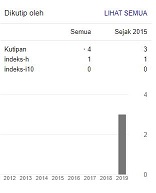ANALISIS FRAUD DIAMOND DALAM MENDETEKSI FRAUDULENT FINANCIAL STATEMENT, STUDI META ANALISIS
Abstract
Penelitian ini bertujuan untuk mengetahui potensi kecurangan laporan keuangan dengan menggunakan analisis fraud diamond. Fraud diamond merupakan konsep yang menjelaskan faktor-faktor penyebab seseorang melakukan kecurangan, yaitu tekanan, kesempatan, rasionalisasi, dan kemampuan. Pada penelitian ini, faktor tekanan diproksikan dengan menggunakan stabilitas keuangan. Faktor kesempatan diproksikan dengan menggunakan sifat industri. Faktor rasionalisasi diproksikan dengan pergantian auditor. Terakhir, faktor kemampuan diproksikan dengan pergantian direksi. Penelitian ini menggunakan manajemen laba untuk melihat potensi kecurangan laporan keuangan. Manajemen laba tersebut diukur menggunakan indikator F-Score. Pemilihan sampel dalam penelitian ini menggunakan metode purposive sampling. Berdasarkan kriteria tersebut, diperoleh sampel sebanyak 24 laporan penelitian. Penelitian ini dilakukan dengan metode kuantitatif, teknik analisis yang digunakan yaitu data meta analisis. Hasil penelitian menunjukkan bahwa hanya variabel kesempatan yang diproksikan dengan sifat industri yang terbukti berpengaruh positif signifikan dalam mendeteksi potensi kecurangan laporan keuangan. Sedangkan variabel tekanan yang diproksikan dengan stabilitas keuangan; variabel kesempatan yang diproksikan dengan sifat industri; variabel rasionalisasi yang dipoksikan dengan pergantian auditor; dan variabel kemampuan tidak berpengaruh dalam mendeteksi potensi kecurangan laporan keuangan.
Keywords
Full Text:
XMLReferences
Abdullahi, R., Mansor, N., Kida, M. I., & Safi, N. (2016). An Empirical Analysis on the Influence of Social Conditioning and Capability toward Financial Fraud in Kano State Public Sectors. Journal of Research in Humanities and Social Sciences, 100–106. https://www.semanticscholar.org/paper/An-Empirical-Analysis-on-the-Influence-of-Social-in-Abdullahi-Mansor/546dee31a818620f63208e713a77c96f0f3f4cb7
American Institute of Certified Public Accountants (AICPA). (2002). Consideration of fraud in a financial statement audit. Statement on Auditing Standards No. 99. October. https://en.wikipedia.org/wiki/Statement_on_Auditing_Standards_No._99:_Consideration_of_Fraud
Christopher J. Skousen, B. J. T. (2009). Fraud in Emerging Markets: A Cross Country Analysis. https://papers.ssrn.com/sol3/papers.cfm?abstract_id=1340586
Cressey, D. R. (1953). Other People’s Money a Study in the Social Psychology of Embezzlement. Glencoe, Ill., Free Press.
Loebbecke, J.K., M. M. E. dan J. J. W. (1989). Auditors’ Experience with Irregularities: Frequency, Nature and Detectability. Auditing : A Journal of Practice & Theory, 9, 1–28.
Lyons, L. C. (2000). Meta-Analysis: Methods of Accumulating Results Across Research Domains. Retrieved February. https://www.semanticscholar.org/paper/Meta-Analysis%3A-Methods-of-Accumulating-Results-Lyons/e6e77da13457ce49407c653f7a8fbbf8ba3ac707
Noble, M. R. (2019). Fraud diamond analysis in detecting financial statement fraud. The Indonesian Accounting Review, 9(2), 121. https://doi.org/10.14414/tiar.v9i2.1632
Romney, B, M., & Steinbart, P. J. (2014). Sistem Informasi Akuntansi: Accounting Information Systems (Edisi 13). Prentice Hall.
Sasongko, N., & Wijayantika, S. F. (2019). FAKTOR RESIKO FRAUD TERHADAP PELAKSANAAN FRAUDULENT FINANCIAL REPORTING (BERDASARKAN PENDEKATAN CROWN’S FRAUD PENTAGON THEORY). Riset Akuntansi Dan Keuangan Indonesia, 4(1), 67–76. https://doi.org/10.23917/reaksi.v4i1.7809
Summers, S. L., & Sweeney, J. T. (1998). Fraudulently misstated financial statements and insider trading: An empirical analysis. Accounting Review, 73(1), 131–146. https://www.academia.edu/904305/Fraudulently_Misstated_Financial_Statements_and_Insider_Trading_An_Empirical_Analysis
Tiffani, L., & Marfuah, M. (2015). Deteksi financial statement fraud dengan
Abdullahi, R., Mansor, N., Kida, M. I., & Safi, N. (2016). An Empirical Analysis on the Influence of Social Conditioning and Capability toward Financial Fraud in Kano State Public Sectors. Journal of Research in Humanities and Social Sciences, 100–106. https://www.semanticscholar.org/paper/An-Empirical-Analysis-on-the-Influence-of-Social-in-Abdullahi-Mansor/546dee31a818620f63208e713a77c96f0f3f4cb7
American Institute of Certified Public Accountants (AICPA). (2002). Consideration of fraud in a financial statement audit. Statement on Auditing Standards No. 99. October. https://en.wikipedia.org/wiki/Statement_on_Auditing_Standards_No._99:_Consideration_of_Fraud
Christopher J. Skousen, B. J. T. (2009). Fraud in Emerging Markets: A Cross Country Analysis. https://papers.ssrn.com/sol3/papers.cfm?abstract_id=1340586
Cressey, D. R. (1953). Other People’s Money a Study in the Social Psychology of Embezzlement. Glencoe, Ill., Free Press.
Loebbecke, J.K., M. M. E. dan J. J. W. (1989). Auditors’ Experience with Irregularities: Frequency, Nature and Detectability. Auditing : A Journal of Practice & Theory, 9, 1–28.
Lyons, L. C. (2000). Meta-Analysis: Methods of Accumulating Results Across Research Domains. Retrieved February. https://www.semanticscholar.org/paper/Meta-Analysis%3A-Methods-of-Accumulating-Results-Lyons/e6e77da13457ce49407c653f7a8fbbf8ba3ac707
Noble, M. R. (2019). Fraud diamond analysis in detecting financial statement fraud. The Indonesian Accounting Review, 9(2), 121. https://doi.org/10.14414/tiar.v9i2.1632
Romney, B, M., & Steinbart, P. J. (2014). Sistem Informasi Akuntansi: Accounting Information Systems (Edisi 13). Prentice Hall.
Sasongko, N., & Wijayantika, S. F. (2019). FAKTOR RESIKO FRAUD TERHADAP PELAKSANAAN FRAUDULENT FINANCIAL REPORTING (BERDASARKAN PENDEKATAN CROWN’S FRAUD PENTAGON THEORY). Riset Akuntansi Dan Keuangan Indonesia, 4(1), 67–76. https://doi.org/10.23917/reaksi.v4i1.7809
Summers, S. L., & Sweeney, J. T. (1998). Fraudulently misstated financial statements and insider trading: An empirical analysis. Accounting Review, 73(1), 131–146. https://www.academia.edu/904305/Fraudulently_Misstated_Financial_Statements_and_Insider_Trading_An_Empirical_Analysis
Tiffani, L., & Marfuah, M. (2015). Deteksi financial statement fraud dengan analisis fraud triangle pada perusahaan manufaktur yang terdaftar di bursa efek Indonesia. Jurnal Akuntansi & Auditing Indonesia, 19(2), 112–125. https://doi.org/10.20885/jaai.vol19.iss2.art3
Wahyuni, W., & Budiwitjaksono, G. S. (2017). FRAUD TRIANGLE SEBAGAI PENDETEKSI KECURANGAN LAPORAN KEUANGAN. Jurnal Akuntansi, 21(1), 47. https://doi.org/10.24912/ja.v21i1.133
Wang, C.S. and Lou, J. C. (2009). Research on GF Company Training System. Journal of Human Resource and Sustainability Studies, 5 No 3. https://www.scirp.org/%28S%28lz5mqp453edsnp55rrgjct55%29%29/reference/referencespapers.aspx?referenceid=2113432
Warsidi, Pramuka, B. A., & Suhartinah. (2018). Determinant Financial Statement Fraud: Perspective Theory of Fraud Diamond (Studi Empiris pada Perusahaan Sektor Perbankan di Indonesia Tahun 2011-2015). Jurnal Ekonomi, Bisnis, Dan Akuntansi (JEBA), 20(3), 1–19.
Wolfe, D. T., & Hermanson, D. R. (2004). The FWolfe, D. T. and Hermanson, D. R. (2004) ‘The Fraud Diamond : Considering the Four Elements of Fraud: Certified Public Accountant’, The CPA Journal, 74(12), pp. 38–42. doi: DOI:raud Diamond : Considering the Four ElemWolfe, D. T. and Hermanson, D. R. The CPA Journal, 74(12), 38–42
Refbacks
- There are currently no refbacks.
Indexing:
Aliansi:
Reference Manager:
View Statistic
Published by Prodi Manajemen Fakultas Ekonomi Universitas Madura
Jl. Raya Panglegur Km 3,5 Pamekasan
Phone: (0324) 322231
website: http://ejournal.unira.ac.id/index.php/jurnal_makro_manajemen/index
Email: [email protected]
MAKRO by Universitas Madura is licensed under a Creative Commons Attribution 4.0 International License.







